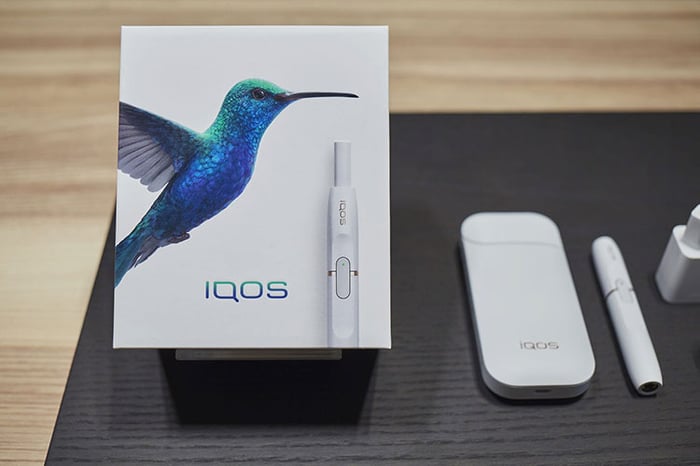After riding high on the potential for its heat-not-burn electronic cigarettes to replace traditional cigarettes, Philip Morris International (PM 3.83%) has delivered a disappointing earnings report that showed a significant slowdown in the e-cig's primary market, Japan.
With its shares down 30% in the past year, let's take a look at what lies ahead for Philip Morris and its e-cig ambitions.

Image source: Philip Morris International.
Unique circumstances
In a steadily declining market, companies seek out a dramatic revitalization of the industry, and Philip Morris seemed to find it in the iQOS e-cig. These devices heat tobacco to the point where it creates a vapor but does not burn. Because the smoke created by combustible cigarettes contains most of the toxic chemicals associated with smoking, the iQOS provided hope of a healthier alternative.
Philip Morris had the inside track on transitioning away from combustible cigarettes. The iQOS was first introduced in selected cities in Japan in 2014 and rolled out nationally last year. Philip Morris saw sales of the device take off. Marketed as Marlboro HeatSticks under a licensing agreement with Altria, the e-cig became the most popular tobacco product Philip Morris sold in Japan, with unit shipments soon surpassing those of traditional cigarettes.
But the Japanese market is an anomaly in that competition for the iQOS was effectively banned. The e-liquids used by other types of electronic cigarettes were regulated as a pharmaceutical ingredient, which effectively prevented sales of other e-cigs. Thus, Philip Morris was able to gain pre-eminence.
Both British American Tobacco and Japan Tobacco have their own competing devices on the market there now, but they also agree the Japanese market is in the grips of an e-cig slowdown. Philip Morris says that it has reached all the early adopters of the new technology, meaning there is fierce competition to convert the older, more conservative smokers to each company's brand. That's leading to price wars, which pressure margins.
An ominous outlook
It also raises the alarm for other markets, most notably the U.S., where Philip Morris is awaiting Food and Drug Administration approval of its application to market the device, possibly with a reduced-risk label.
At this point it seems difficult to imagine the regulatory agency will go against the recommendation of its advisory board, which said the tobacco giant should be denied the ability to market its e-cig as a reduced-risk product. But it also seems like regulators will approve its sale to the public, though perhaps with additional conditions.
Recently the FDA began cracking down on the popularity of e-cigs with teenagers, particularly going after JUUL Labs. Its e-cig, which uses a different technology than the iQOS to deliver nicotine to users, was found to be exceptionally popular with school-age kids, quite possibly because it looks like a thumb drive and is easily concealed.
Though Philip Morris had hoped the iQOS would receive similar treatment here as it did in Japan, that may not pan out. First, e-cigs that use e-liquids are legal and very popular here. Second, JUUL owns half the e-cig market at the moment, coming virtually out of nowhere to displace British Tobacco's once-leading Vuse offering (which it acquired from Reynolds American) as the leading electronic cigarette.

Vials of nicotine e-liquids. Image source: Getty Images.
Where does Philip Morris go from here?
So where does that put Philip Morris International? Its vision of a smoke-free future is fraught with more risks than originally believed.
But the sell-off in its shares might have been overdone. Altria's Marlboro brand is the biggest, with a 50% share and selling the iQOS under that banner will help, particularly as a relatively large segment of the population here are currently e-cig users. According to data from the Centers for Disease Control, 3.2% of all U.S. adults in 2016 used electronic cigarettes. And among users 45 and older in 2015, most were former smokers.
That suggests Philip Morris might not have the same trouble connecting to the older smokers in the U.S. that it encountered in Japan. While competition might be more fierce here, there may be more opportunity.
Trading at 16x forward earnings estimates, Philip Morris International might be showing investors an attractive discount that comes with a hefty dividend currently yielding 5.5%. But the ongoing headwinds across its business leave investors with a particularly difficult choice as the company hopes for a turnaround.





